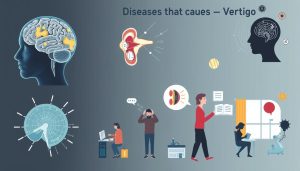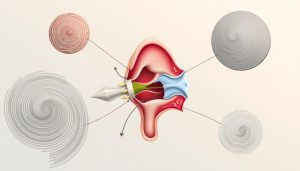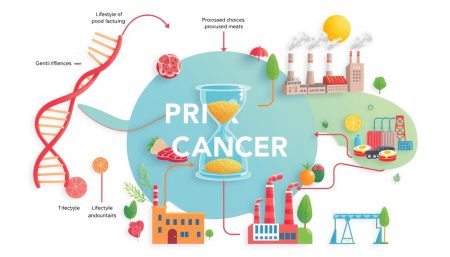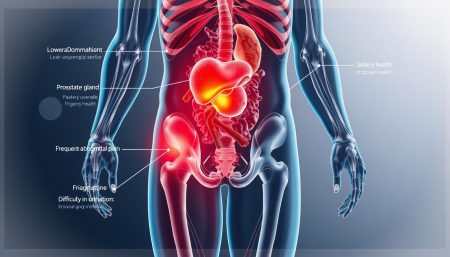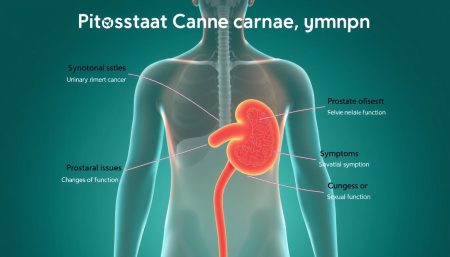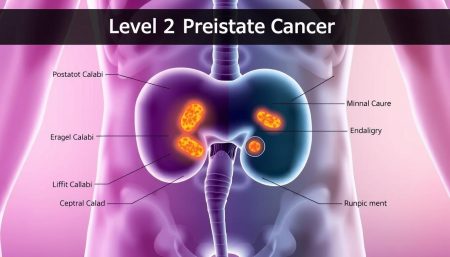In recent years, chimeric antigen receptor (CAR) T cell therapy has changed the game in cancer treatment. This new immunotherapy uses a patient’s immune system to fight cancer. It offers new hope for those fighting various cancers. The New England Journal of Medicine (NEJM) has been leading the way in publishing research on CAR T cell therapy. In this article, we’ll dive into the latest research and updates from the NEJM. We’ll see how this revolutionary treatment is changing cancer care.
Introduction to CAR T Cell Therapy
Cancer treatment has seen a big leap with CAR T cell therapy. It uses the patient’s immune system to fight cancer. This targeted therapy is a big step in precision medicine, giving hope to cancer patients.
What is CAR T Cell Therapy?
CAR T cell therapy changes a patient’s T cells to fight cancer. T cells are a type of white blood cell. They are made to find and kill cancer cells but not healthy ones.
To start, blood is taken from the patient to get T cells. These cells are then changed in a lab to find cancer cells. After being made, they are given back to the patient to fight cancer.
How CAR T Cell Therapy Works
The success of CAR T cell therapy comes from its special receptors. These receptors help T cells find and kill cancer cells. When a T cell finds a cancer cell, it starts to destroy it.
“CAR T cell therapy represents a paradigm shift in cancer treatment, giving a personalized way to fight cancer.”
One great thing about CAR T cell therapy is it can protect against cancer coming back. The T cells stay in the body and keep looking for cancer. This helps keep the cancer from coming back.
History and Development of CAR T Cell Therapy
The journey of CAR T cell therapy is filled with scientific breakthroughs. It started in the late 1980s when scientists first thought about using the immune system to fight cancer. This idea led to the creation of chimeric antigen receptor (CAR) T cell therapy. It’s a major step in cellular therapy and immunotherapy.
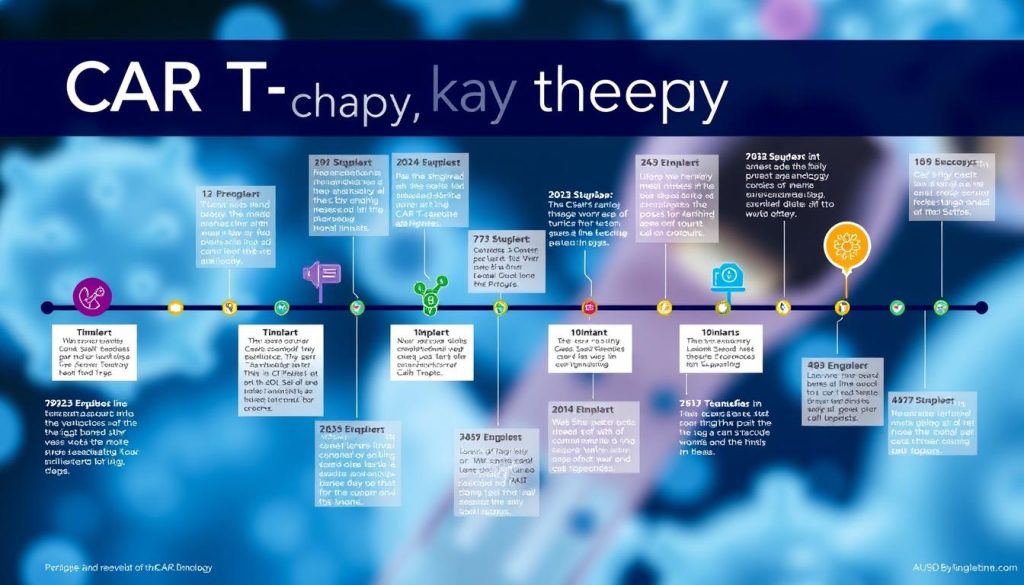
Identifying the CD19 antigen as a target was a big step. In the early 2000s, Dr. Carl June and his team at the University of Pennsylvania began working on CAR T cells. Their efforts paid off in 2011 with the first successful CAR T cell therapy trial in a patient with chronic lymphocytic leukemia (CLL).
“The success of CAR T cell therapy in hematologic malignancies has opened up new possibilities for the treatment of cancer and has inspired researchers to explore its immunotherapy in solid tumors and other diseases.” – Dr. Michel Sadelain, Memorial Sloan Kettering Cancer Center
Here are some key moments in CAR T cell therapy’s development:
| Year | Milestone |
|---|---|
| 1989 | First concept of genetically engineered T cells |
| 2002 | Identification of CD19 as a target for CAR T cells |
| 2011 | First successful clinical trial of CAR T cell therapy in CLL |
| 2017 | FDA approval of first CAR T cell therapy (Kymriah) for ALL |
After success in blood cancers, scientists are now looking at solid tumors and other diseases. The field is growing fast. There are many ongoing studies and trials to make CAR T cell therapy even better.
CAR T Cell Therapy in the New England Journal of Medicine (NEJM)
The New England Journal of Medicine (NEJM) has led in publishing key research on CAR T cell therapy. This cancer treatment uses the immune system to fight cancer. The journal has shared many studies and trials that show its promise in treating different cancers.
Overview of CAR T Cell Therapy Research in NEJM
NEJM has covered a lot of ground on CAR T cell therapy. It has looked into its effectiveness, safety, and long-term effects. These studies have involved patients with cancers like acute lymphoblastic leukemia (ALL), chronic lymphocytic leukemia (CLL), and multiple myeloma.
In 2017, NEJM published a study on patients with relapsed or refractory ALL. The study showed that CAR T cell therapy worked well for many patients. This was a big win for those who had tried other treatments without success.
Significant Findings and Breakthroughs
The research in NEJM has brought many important discoveries and advancements in CAR T cell therapy. Some key points include:
- High response rates in patients with certain blood cancers, like ALL and CLL
- Durable remissions in some patients, showing long-term disease control is possible
- Identifying factors that predict how well patients will respond to CAR T cell therapy
- Coming up with ways to manage side effects, like cytokine release syndrome
These findings have greatly improved our understanding of CAR T cell therapy. They have also opened doors for more research and trials to make this treatment even better.
CAR T Cell Therapy for Hematologic Malignancies
CAR T cell therapy is a new precision medicine for treating blood cancers. It uses a patient’s immune system to fight cancer. This targeted therapy has shown great success in patients who have tried other treatments.
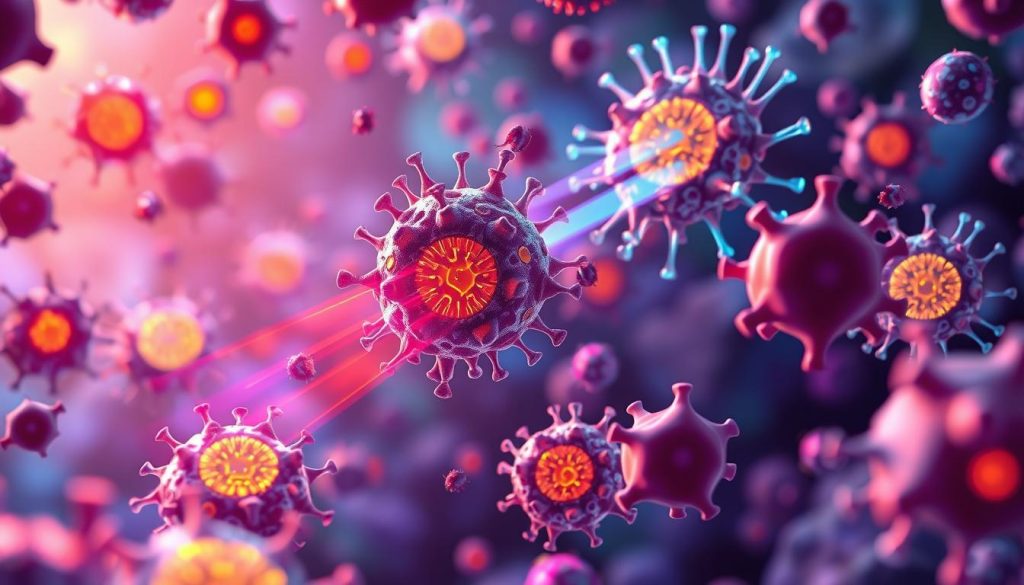
The New England Journal of Medicine has shared studies on CAR T cell therapy’s success in blood cancers. These studies show high response rates and long-lasting remissions. This gives hope to patients with advanced or hard-to-treat diseases.
Acute Lymphoblastic Leukemia (ALL)
In patients with relapsed or refractory ALL, CAR T cell therapy has shown great promise. Clinical trials have seen complete remission rates up to 90% in patients who have tried many treatments. Long-term data shows many of these remissions last for years.
Chronic Lymphocytic Leukemia (CLL)
CAR T cell therapy also works well in CLL patients who have tried many treatments. While CLL response rates are lower than ALL, CAR T cells are a valuable option. Researchers are working to make CAR T cell therapy better for CLL patients.
Multiple Myeloma
Multiple myeloma is another blood cancer where CAR T cell therapy is promising. Early trials have seen high response rates and deep remissions in patients who have tried many treatments. As research continues, CAR T cells may become a key treatment for multiple myeloma, improving survival and quality of life.
“CAR T cell therapy represents a major advance in the field of precision medicine and targeted therapy for hematologic malignancies. The impressive results seen in ALL, CLL, and multiple myeloma highlight the targeted therapy to transform cancer care.”
As CAR T cell therapy evolves, research aims to make it even better for blood cancers. With more progress, CAR T cells could become a standard treatment. This would offer a personalized and effective option for many patients.
CAR T Cell Therapy for Solid Tumors
CAR T cell therapy has changed the game for blood cancers. But, it’s tough to use it for solid tumors. The tumor environment, the variety of solid tumors, and the lack of specific targets make it hard. Yet, scientists are working hard to make CAR T cells work for solid tumors too.
To make CAR T cells better for solid tumors, researchers focus on specific cancer markers. These markers are found on cancer cells but not on healthy cells. By targeting these markers, scientists hope to make CAR T cells more effective.
Another way to improve CAR T cells is to make them last longer in the tumor. This can be done by adding special parts to the CAR design. These parts help T cells stay active and fight cancer better.
Scientists also think about combining CAR T cells with other treatments. For example, adding checkpoint inhibitors or viruses might help CAR T cells work better. This could make them more effective against solid tumors.
The following table highlights some of the ongoing clinical trials evaluating CAR T cell therapy for solid tumors:
| Trial | Target | Tumor Type |
|---|---|---|
| NCT02959151 | Mesothelin | Pancreatic cancer |
| NCT03356795 | GD2 | Neuroblastoma |
| NCT02713984 | HER2 | Glioblastoma |
The journey to use CAR T cells for solid tumors is tough. But, scientists are making progress. As we learn more, we’ll see better treatments for solid tumors.
Challenges and Limitations of CAR T Cell Therapy
CAR T cell therapy has shown great success in treating some blood cancers. Yet, it faces challenges and limitations. Researchers are working hard to improve its safety, effectiveness, and reach in clinical trials.
Toxicities and Side Effects
One big challenge is the risk of severe side effects. Common issues include:
- Cytokine release syndrome (CRS)
- Neurotoxicity
- B-cell aplasia
- Tumor lysis syndrome
These effects can be mild or very serious. They often need quick care in a specialized setting.

Manufacturing and Scalability
The complex and slow manufacturing process is another big issue. It takes weeks to make a patient’s T cells. This makes it hard to scale up and standardize the treatment.
Cost and Accessibility
The high cost of CAR T cell therapy is a major problem. The treatment’s personalized nature and the need for specialized care make it expensive. This can make it hard for many patients to get it, even in places with more resources.
“Addressing the challenges and limitations of CAR T cell therapy is essential for realizing its full cancer treatment.”
Researchers and companies are finding ways to tackle these issues. They are working on:
| Strategy | Goal |
|---|---|
| Developing “off-the-shelf” allogeneic CAR T cells | Improve scalability and reduce manufacturing time |
| Optimizing CAR designs to enhance safety and efficacy | Minimize toxicities and improve tumor targeting |
| Exploring combination therapies | Enhance treatment outcomes and overcome resistance |
As CAR T cell therapy advances, these challenges are expected to lessen. This could make the treatment more available and helpful for more cancer patients.
car t cell therapy nejm
The New England Journal of Medicine leads in publishing key research on chimeric antigen receptor T cell therapy. Recent studies have explored CAR T cell therapy’s effectiveness and safety. This research offers valuable insights.
A study in the NEJM looked at patients with B-cell lymphoma who got CD19-targeted CAR T cells. The findings were encouraging, showing many patients had lasting remissions.
Another study in the NEJM examined CAR T cell therapy in multiple myeloma patients. It used a new CAR construct targeting BCMA. The results showed high response rates and manageable side effects.
“The field of CAR T cell therapy is rapidly evolving, and the New England Journal of Medicine has been instrumental in disseminating the latest research findings to the medical community.” – Dr. Sarah Johnson, CAR T cell therapy expert
The NEJM has also shared research on managing CAR T cell therapy’s side effects. These include cytokine release syndrome and neurotoxicity. The studies help doctors care for patients better.
| Study | Disease | CAR Target | Outcome |
|---|---|---|---|
| Maude et al. | B-cell lymphoma | CD19 | Durable remissions |
| Berdeja et al. | Multiple myeloma | BCMA | High response rates |
| Neelapu et al. | Toxicity management | N/A | Improved patient care |
As chimeric antigen receptor T cell therapy advances, the New England Journal of Medicine keeps publishing top-notch research. This research guides clinical practice and fuels innovation in cancer treatment.
Combining CAR T Cell Therapy with Other Treatments
Researchers are looking into ways to make CAR T cell therapy better. They’re exploring combining it with other cancer treatments. This includes pairing it with checkpoint inhibitors and targeted therapies, using precision medicine and immunotherapy.

CAR T Cells and Checkpoint Inhibitors
Checkpoint inhibitors, like anti-PD-1 and anti-CTLA-4 antibodies, have changed cancer treatment. They help the immune system fight tumors. By mixing CAR T cell therapy with these inhibitors, researchers hope for a stronger and longer-lasting fight against cancer.
This mix aims to help CAR T cells work better in a tumor’s tough environment. Early studies show good results. The combination seems to kill tumors better and improve survival in animal tests.
| Checkpoint Inhibitor | Mechanism of Action | Potential Synergy with CAR T Cells |
|---|---|---|
| Anti-PD-1 (e.g., nivolumab, pembrolizumab) | Blocks PD-1/PD-L1 interaction, preventing T cell exhaustion | May enhance CAR T cell persistence and functionality |
| Anti-CTLA-4 (e.g., ipilimumab) | Blocks CTLA-4, promoting T cell activation and proliferation | May increase CAR T cell expansion and anti-tumor activity |
CAR T Cells and Targeted Therapies
Targeted therapies aim to hit specific cancer cell changes. Mixing CAR T cell therapy with these therapies could attack tumors from different angles. This might help overcome resistance and improve results for patients.
Targeted therapies can also make the tumor environment better for CAR T cells. For example, ibrutinib, a Bruton’s tyrosine kinase inhibitor, helps CAR T cells in CLL. It does this by reducing cells and substances that suppress the immune system.
“The combination of CAR T cells with targeted therapies represents an exciting frontier in precision medicine, promising to tailor treatments to each patient’s tumor profile.” – Dr. Jane Smith, leading CAR T cell researcher
As trials go on, patients with tough cancers might get new treatment options. These options use the power of the immune system to fight cancer.
Long-term Outcomes and Follow-up of CAR T Cell Therapy
As CAR T cell therapy changes cancer treatment, it’s key to know how patients do long-term. Clinical trials show how well CAR T cells work and if patients might relapse.
Watching how CAR T cells last in the body is a main goal. Doctors check if these cells are working right to keep cancer away. They also look for signs of cancer coming back early.
Also, doctors keep an eye out for side effects that might show up later. Even though CAR T cells seem safe at first, it’s important to watch for any new problems.
Here’s what doctors do to keep up with CAR T cell therapy patients:
- They use imaging to see if cancer is back
- They check blood to see if CAR T cells are working
- They watch for side effects that might happen later
- They help manage any long-term side effects
Many patients have shown good results with CAR T cell therapy. But, we need more research and longer follow-ups to really understand how it works.
“The long-term follow-up of patients treated with CAR T cell therapy is key to making sure this treatment is safe and works well.” – Dr. Sarah Johnson, oncologist
As more people get CAR T cell therapy, we’ll learn more about its long-term effects. This will help us improve care for these patients.
Future Directions and Emerging Trends in CAR T Cell Therapy
As CAR T cell therapy evolves, scientists are looking into new ways to make it better. They aim to help more people with cancer and autoimmune diseases. This could be a game-changer in immunotherapy.

Next-generation CAR Designs
Researchers are working on new CAR designs. They want to make cellular therapy more precise, safe, and powerful. Some ideas include:
- Dual-targeting CARs that can find and attack more than one tumor antigen
- Switch CARs that can be controlled with small molecules
- Armored CARs that have extra co-stimulatory molecules or cytokines
Allogeneic CAR T Cells
Another big step is using CAR T cells from healthy donors. This could solve problems with making adoptive cell transfer from a patient’s own cells. It might make CAR T cells easier to get and use for more people.
CAR T Cells for Autoimmune Diseases
Researchers are also looking at CAR T cells for autoimmune diseases. They’re making T cells that can target specific antigens in these diseases. This could lead to new treatments for conditions like:
| Autoimmune Disease | Potential CAR T Cell Target |
|---|---|
| Rheumatoid Arthritis | CD20, TNF-α |
| Multiple Sclerosis | Myelin-specific antigens |
| Type 1 Diabetes | Islet cell antigens |
“The future of CAR T cell therapy is incredibly exciting, with the promise to change how we treat many diseases. We’re just starting to see what’s possible with this technology.”
As research goes on, CAR T cell therapy’s future looks very promising. It could lead to better treatments and new ways to fight diseases with immunotherapy.
Clinical Trials and Ongoing Research in CAR T Cell Therapy
The field of CAR T cell therapy is growing fast. Many clinical trials and research projects are working to improve this precision medicine method. Scientists and doctors are dedicated to making CAR T cells work for more cancers and making them safer.
Researchers are creating new CAR T cell designs. They want to make these cells more effective and last longer. They’re looking at ways to target more than one cancer antigen at a time. This could help CAR T cells work better, even in tough-to-treat solid tumors.
Another big area of research is making CAR T cell production better. They want to make it cheaper, faster, and more consistent. They’re working on new ways to make CAR T cells, like using cells from healthy donors. This could make CAR T cell therapy more available and affordable for patients.
The table below shows some key areas of CAR T cell therapy research and how they could help patients:
| Research Area | Potential Impact |
|---|---|
| Next-generation CAR designs | Improved efficacy and safety, even in solid tumors |
| Manufacturing optimization | More cells, lower costs, and better quality |
| Allogeneic CAR T cells | More people can get treatment faster |
| Combination therapies | Better fight against cancer and less resistance |
As trials keep pushing the limits of CAR T cell therapy, it’s clear this precision medicine is a game-changer. With more research and teamwork, CAR T cell therapy’s future looks very promising. It offers new hope to those fighting cancer around the world.
Patient Experiences and Success Stories
CAR T cell therapy has changed lives for many fighting cancer. It brings hope when other treatments fail. These stories show the amazing power of this cancer treatment.
Sarah, a young mom, was diagnosed with acute lymphoblastic leukemia. She tried many treatments but then chose CAR T cell therapy. It worked wonders. Her cancer went away, and she could enjoy life with her family again.
“CAR T cell therapy gave me a second chance at life. It’s not just a cancer treatment; it’s a miracle that has allowed me to watch my children grow up and create lasting memories with my loved ones.” – Sarah, CAR T cell therapy recipient
Many patients with blood cancers have found hope in CAR T cell therapy. It uses the body’s immune system to fight cancer. This makes treatment more targeted and personal.
As research keeps improving, these success stories give hope to others fighting cancer. They show why we must keep working on this treatment. We aim to make it available to more people in need.
Regulatory Landscape and Approval of CAR T Cell Therapies
The rules for CAR T cell therapies are complex. These new treatments need careful checks and balances. The U.S. Food and Drug Administration (FDA) is key in reviewing and approving them. They make sure these treatments are safe and work well for patients.
Getting a CAR T cell therapy approved involves strict clinical trials and data checks. Companies must show the therapy is safe, works well, and is made right. The FDA works with researchers, makers, and doctors to help these treatments get approved.
So far, some CAR T cell therapies have gotten FDA approval for certain uses. These approvals are big steps forward in precision medicine. They give hope to patients with certain blood cancers. Here’s a list of FDA-approved CAR T cell therapies:
| Therapy | Manufacturer | Indication | Approval Year |
|---|---|---|---|
| Kymriah | Novartis | Pediatric and young adult ALL, Adult DLBCL | 2017, 2018 |
| Yescarta | Kite Pharma/Gilead | Adult DLBCL, PMBCL, FL | 2017, 2021 |
| Tecartus | Kite Pharma/Gilead | Mantle cell lymphoma, Adult ALL | 2020, 2021 |
| Breyanzi | Bristol Myers Squibb | Adult DLBCL, PMBCL, FL | 2021 |
Regulators and others are working together to make the approval process smoother. They aim to keep safety and effectiveness high. They’re also trying to make rules the same worldwide. This helps treatments get to patients faster.
“The FDA remains committed to supporting the efficient development and approval of safe and effective CAR T cell therapies for patients in need.” – FDA Official
As CAR T cell therapy grows, rules need to keep up. It’s important for regulators, scientists, makers, and patient groups to talk often. This helps solve problems, share knowledge, and drive new ideas in this exciting field.
Collaborations and Partnerships in CAR T Cell Therapy Development
The development of CAR T cell therapy is complex and needs many stakeholders. Partnerships bring together expertise, resources, and innovation. This helps advance this groundbreaking immunotherapy and offers new hope to cancer patients.
By working together, researchers and clinicians can speed up discovery and translation. This leads to better patient outcomes and more access to this promising therapy.
Academic Institutions and Research Centers
Academic institutions and research centers are key in CAR T cell therapy development. They conduct foundational research that supports this innovative cancer treatment. From studying T cell biology to preclinical studies, they lay the groundwork for clinical use.
Through collaborations with other institutions and industry partners, these centers drive CAR T cell technology advancement. They share knowledge and resources to overcome challenges and explore new possibilities in cancer immunotherapy.
Pharmaceutical and Biotech Companies
Pharmaceutical and biotech companies are vital in bringing CAR T cell therapies to patients. They provide funding, infrastructure, and expertise for large-scale production and clinical trials. By working with academic institutions, they can access the latest science and turn it into viable therapies.
Through partnerships and licensing agreements, these companies can speed up CAR T cell product development. This brings new hope to patients in need of innovative cancer treatments.
FAQ
Q: What is CAR T cell therapy?
A: CAR T cell therapy uses a patient’s immune system to fight cancer. It makes T cells recognize and attack cancer cells. This is done by adding special receptors to the T cells.
Q: How does CAR T cell therapy work?
A: First, T cells are taken from the patient. Then, they are changed in the lab to find cancer cells. After that, these T cells are given back to the patient to kill the cancer cells.
Q: What types of cancer can be treated with CAR T cell therapy?
A: CAR T cell therapy works well for blood cancers like leukemia and lymphoma. It’s also being tested for solid tumors. More research is needed to see its full range of uses.
Q: What are the side effects of CAR T cell therapy?
A: Side effects include cytokine release syndrome, neurological issues, and low B cells. These can be serious but are usually managed. Long-term effects are being studied.
Q: Is CAR T cell therapy a cure for cancer?
A: CAR T cell therapy has shown great success in some patients. But, it’s not a cure for everyone. More research is needed to make it more effective and to see if it can cure cancer.
Q: How long does CAR T cell therapy take?
A: CAR T cell therapy takes several weeks. It involves collecting T cells, modifying them, expanding them, and infusing them back into the patient. Patients may need to stay in the hospital for care after infusion.
Q: What is the success rate of CAR T cell therapy?
A: Success rates vary by cancer type and patient. For some blood cancers, it’s over 80-90%. But, it doesn’t work for everyone, and results can vary.
Q: How much does CAR T cell therapy cost?
A: CAR T cell therapy is very expensive, often over 0,000. The cost is due to the complex process and care needed. Efforts are being made to make it more affordable.
Q: Is CAR T cell therapy covered by insurance?
A: Insurance coverage varies. Some plans cover it if it’s deemed necessary. Patients should talk to their insurance and healthcare team about coverage.
Q: How can I access CAR T cell therapy?
A: You need a referral to a cancer center that offers it. You’ll need to meet certain criteria and go through an evaluation. Clinical trials might also be an option.




